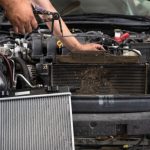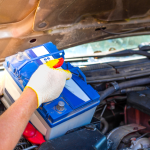When it comes to understanding your vehicle’s engine, many components play a crucial role in ensuring everything runs smoothly. Among those components, the throttle body often goes unnoticed, yet it is essential for managing air intake and fueling the engine’s performance. Whether you’re a car enthusiast or just someone who wants to understand how their vehicle operates, grasping the basics of the throttle body can provide valuable insights into your engine’s efficiency and responsiveness.
In this article, we’ll demystify the throttle body, explain its function, and highlight why it matters. So buckle up as we take a friendly dive into this key engine component!
Table of Contents
- Understanding the Role of the Throttle Body in Engine Performance
- How Throttle Bodies Work: Mechanics Behind the Power
- Common Signs of a Failing Throttle Body and What to Watch For
- Tips for Maintaining Your Throttle Body and Ensuring Optimal Function
- Q&A
- Key Takeaways

Understanding the Role of the Throttle Body in Engine Performance
The throttle body is a critical component of your vehicle’s fuel injection system, serving as the gateway for air to enter the engine. When you press the accelerator pedal, the throttle body opens to allow more air in, which is essential for increasing engine power and responsiveness. This precise control over air intake directly affects how well your engine performs, as it influences fuel atomization and combustion efficiency. A well-functioning throttle body ensures a correct air-fuel mixture, which is vital for optimal engine performance and fuel economy.
Several factors can impact the performance of the throttle body, including:
- Throttle Position Sensor (TPS): This sensor monitors the position of the throttle plate and sends data to the engine control unit (ECU) to adjust the fuel injection accordingly.
- Carbon Buildup: Over time, carbon deposits can accumulate inside the throttle body, restricting airflow and negatively affecting engine performance.
- Electronic Control: Many modern vehicles use electronically controlled throttle bodies, allowing for more precise management of the air intake based on driving conditions.
Understanding the role of the throttle body and its implications on overall engine performance can help you identify potential issues early on. Regular maintenance, such as cleaning or replacing the throttle body, can prevent performance degradation and enhance your driving experience.

How Throttle Bodies Work: Mechanics Behind the Power
At the heart of an engine’s performance lies the throttle body, a component responsible for regulating the airflow entering the engine. When you press the accelerator pedal, this mechanism opens the throttle plate, allowing air to flow into the intake manifold. This influx of air is crucial as it mixes with fuel in the combustion chamber, creating the power that drives your vehicle. The amount of air allowed in is finely tuned by the electronic throttle control (ETC) system in modern vehicles, which responds to driver input and optimizes airflow for efficiency and performance.
Several key components work together to ensure the throttle body functions smoothly:
- Throttle Plate: A butterfly valve that opens and closes to control airflow.
- Position Sensor: Monitors the angle of the throttle plate and relays data to the engine control unit (ECU).
- Actuator: An electric motor that adjusts the throttle plate’s position based on signals from the ECU.
- Intake Manifold: Directs the airflow into the engine cylinders.
To illustrate the importance of the throttle body in an engine’s operation, consider the impact of different throttle sizes:
| Throttle Size (mm) | Effect on Performance |
|---|---|
| 60 | Improved torque at lower RPMs |
| 70 | Balanced performance for daily driving |
| 80 | Enhanced power at high RPMs, ideal for racing |
Common Signs of a Failing Throttle Body and What to Watch For
A throttle body that is beginning to fail can exhibit several telltale signs. Being aware of these indicators can help you catch issues early and potentially save on costly repairs. Pay close attention to the following common symptoms:
- Unresponsive Acceleration: If you notice a delay or a lack of responsiveness when you press the gas pedal, it could indicate a problem with the throttle body.
- Rough Idling: A fluctuating or rough idle can signal that the throttle body is not functioning correctly, affecting the air-fuel mixture.
- Check Engine Light: Frequent illumination of the check engine light can be a direct result of a failing throttle body.
- Engine Stalling: If your vehicle stalls while driving or at a stop, it may suggest that the throttle body is unable to regulate airflow properly.
In addition to these symptoms, visual and performance checks can help you determine the condition of your throttle body. Consider these diagnostic tips:
- Inspect for Dirt and Debris: A buildup of grime can disrupt airflow; a clean throttle body promotes better performance.
- Listen for Unusual Sounds: Whistling or hissing noises when accelerating may indicate air leaks around the throttle body.
- Monitor Fuel Efficiency: A noticeable drop in miles per gallon could suggest your throttle body is struggling to regulate airflow effectively.

Tips for Maintaining Your Throttle Body and Ensuring Optimal Function
Maintaining your throttle body is essential for ensuring your vehicle runs smoothly and efficiently. Regular inspections are key; consider checking your throttle body for any signs of buildup or debris that can affect its performance. Here are some practical tips to keep in mind:
- Clean the throttle body: Cleaning it every 30,000 miles can prevent carbon buildup, enhancing airflow and fuel efficiency.
- Inspect the gasket: Make sure the throttle body gasket is not cracked or worn to avoid vacuum leaks that can compromise engine performance.
- Check electrical connections: Ensure that all connections are secure and free from corrosion to maintain proper functionality of the throttle position sensor.
Additionally, staying vigilant about any changes in your vehicle’s acceleration can be a telltale sign that your throttle body needs attention. If you notice stalling, hesitation, or a decrease in horsepower, it might be time for a thorough inspection. Keeping a record of maintenance can also help you identify any patterns that may arise over time. Here’s a simple table to guide your maintenance schedule:
| Maintenance Task | Frequency |
|---|---|
| Throttle Body Cleaning | Every 30,000 miles |
| Gasket Inspection | Every oil change |
| Electrical Connection Check | Every 10,000 miles |
Q&A
Q&A:
Q: What exactly is a throttle body?
A: The throttle body is a crucial component in your vehicle’s air intake system. It controls the amount of air that flows into the engine’s intake manifold, which is essential for the combustion process. By regulating the airflow, the throttle body helps manage engine power output and efficiency.
Q: How does a throttle body work?
A: When you press the accelerator pedal, it sends a signal to the throttle body to open the throttle plate, allowing air to enter the engine. This increased airflow results in more fuel being injected, which in turn boosts power. In modern vehicles, this process is often controlled electronically (known as an electronic throttle control), rather than by a mechanical cable.
Q: What are the main components of a throttle body?
A: A typical throttle body consists of several key parts: the throttle plate (the flap that opens and closes), a motor (for electronic throttle control), sensors (like the throttle position sensor), and sometimes a housing that connects it to the air intake system. These components work together to ensure the engine receives the right amount of air.
Q: Why is the throttle body important for engine performance?
A: The throttle body plays a vital role in your engine’s performance and efficiency. A properly functioning throttle body ensures the right air-fuel mixture, which is crucial for optimal combustion. If the throttle body is clogged or malfunctioning, it can lead to poor acceleration, reduced fuel efficiency, and even engine stalling.
Q: How can I tell if my throttle body needs cleaning or replacement?
A: Signs of a problematic throttle body may include rough idling, hesitation when accelerating, poor fuel economy, or the check engine light turning on. If you notice any of these issues, it’s a good idea to have your throttle body inspected and cleaned by a professional mechanic.
Q: Can I clean the throttle body myself?
A: Yes, cleaning the throttle body can be a DIY task for those with basic automotive skills. You’ll need a throttle body cleaner and a few tools. Make sure to disconnect the battery and remove any necessary components for access. However, if you’re unsure or uncomfortable, it’s always best to consult a professional.
Q: How often should the throttle body be serviced?
A: It’s generally a good idea to inspect and clean your throttle body during regular maintenance, such as when you change your air filter or fuel injectors. A thorough cleaning every 30,000 to 50,000 miles can help keep it functioning optimally, but this can vary based on driving conditions and your vehicle’s make and model.
Q: What happens if I ignore throttle body issues?
A: Ignoring throttle body problems can lead to more serious engine issues over time, such as poor fuel consumption, increased emissions, and, in some cases, complete engine failure. Addressing issues early on can save you both time and money in the long run.
By understanding the role of the throttle body and recognizing its importance, you can better maintain your vehicle’s performance and ensure a smooth driving experience. Happy driving!
Key Takeaways
the throttle body may be a small component, but its role in your engine’s performance is immense. By managing the airflow into the engine, it directly influences how your vehicle accelerates and responds to your commands. Understanding how this essential piece works can empower you as a car owner, helping you recognize the signs of wear and tear and make informed decisions about maintenance and repairs.
Whether you’re a seasoned gearhead or just starting to learn about automotive systems, having a solid grasp of your throttle body’s function can enhance your appreciation for the intricate engineering behind modern vehicles. So next time you hit the gas pedal, remember the vital role your throttle body plays in unleashing that power! Happy driving, and here’s to many smooth rides ahead!











